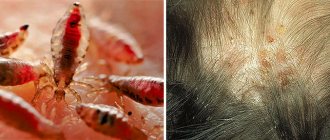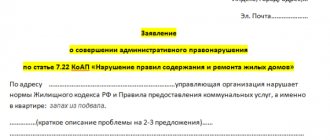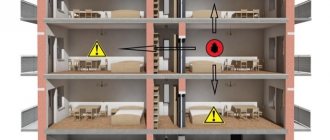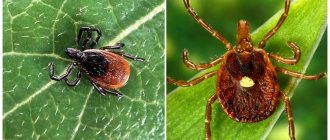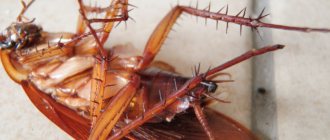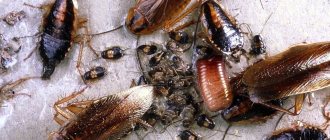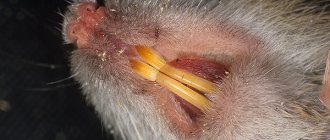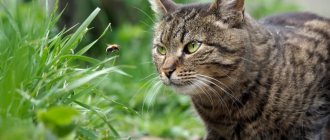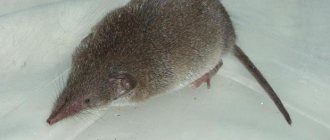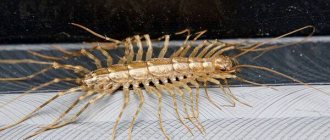Lice in kindergartens
Parents should clearly understand that head lice is a common disease. It does not carry any intimate factors. Infection of a child with head lice in a kindergarten group is quite common. This is due to the large concentration of people in a confined space. Main methods of infection:
- Contact: lice are transmitted through close interaction from child to child during games and activities.
- When exchanging personal items : children love to exchange clothing items, including hats; in addition, the use of shared hygiene products, such as combs and towels, can lead to the transfer of lice and nits.
- Shared bed : Contact with other people's bedding during quiet times can also lead to parasite infection.
Pediculosis in children is usually a widespread disease. If one child is infected, there is a high probability that almost the entire group will become infected.
It is worth understanding that there is practically no fault of kindergarten employees in infecting a child with lice. Educators may not notice a small bug on the head of one child whose parents did not look after him, and after a week the whole group will go into quarantine. It is impossible to completely protect a child from lice infection. Check your child's hair regularly to prevent the spread of parasites at an early stage.
“The SES and the director must treat the entire school from the attic to the basement with chemicals! Manually!"
SES no longer exists. There is a successor to this organization - Rospotrebnadzor, which ensures that schools carry out “anti-pediculosis measures.” But this does not mean that the building must be dismantled brick by brick. Here is what is said on this topic in the decree of the chief sanitary doctor of the Russian Federation dated 06/07/2017 (in Appendix No. 2): “In the outbreak of head lice, treatment of furniture, walls, floors, and clothing is not required. Mats in school gyms must be treated.”
And only if body lice, and not head lice, were found (they often live on homeless people, and are very rarely brought into schools), serious sanitation is required. The above resolution says: “When body lice are detected, anti-pediculosis measures are carried out in the outbreak, as well as in places where people and their clothes are examined, premises (floor, chairs, couches, door handles and other objects) with pediculicidal agents.
Uninvited guests. What myths about head lice are especially active? More details
What must a kindergarten do to prevent head lice?
The spread of head lice in preschool institutions is due to the fact that a child under 7 years of age has not yet mastered the complex of independent hygiene. A large gathering of small children leads to lightning-fast infection.
In kindergartens of all types, preventive measures must be carried out. The regulations establish the following procedure:
- Conducting scheduled conversations and briefings with parents as part of the parent meeting. On the agenda are the main methods of prevention and ways to combat the disease.
- Examination of a newly arrived child by a regular health worker. If parasites are found, the child is not allowed into the institution. After treatment, the child’s parents must provide an appropriate certificate from the clinic indicating complete recovery.
- Routine examination of children is carried out at least once a month . Data from the examination of pupils is recorded in a special journal. Patients are sent for treatment.
Preventive actions by educators, health workers and parents will help minimize the risk of an epidemic.
Memo for parents
If there is lice in kindergarten, what should parents do? First of all, do not panic and remain calm. There are various ways to remove lice and nits without problems or health consequences.
Algorithm of actions for parents:
- • conduct a thorough examination of all family members to identify those infected;
- • carry out immediate and simultaneous treatment of everyone who has parasites;
- • apply the lice remover to damp hair following the instructions
- • after treatment, you need to carefully comb the child’s hair with a fine-toothed comb in order to completely get rid of nits;
- • all procedures must be performed with gloves and an apron, the comb is disinfected after treatment.
In the future, parents must follow preventive measures to prevent re-infection.
Causes of lice in children
There are many opinions about the nature of lice on the human hair and body. These include chronic diseases, poor hygiene and even stress. However, the main and almost the only reason is direct infection . Lice can only be transmitted from someone, but in no case appear out of nowhere on their own; lice do not appear from stress, nerves or hepatitis.
Pediculosis can be contracted through any contact with an infected person, or through an item with which he has recently been in contact.
There is an opinion that lice, like fleas, can jump and move from person to person, jumping on heads. This is wrong. Infection can occur through contact. Cases of infection often occur in cinemas, fitting rooms or on public transport.
Kindergarten and other institutions are the most favorable places. With a large gathering of children, the risk increases significantly.
No matter how much you care for your baby, you cannot deprive him of contact with other children. Therefore, check your child’s hair regularly after playing with friends, especially if there has been contact with children from disadvantaged families. It is much easier to treat pediculosis at an early stage than in its advanced form.
It is worth remembering that lice is not a disease of a dirty head. Adult parasites feel great on clean skin.
What are lice?
The life cycle of these insects lasts approximately three weeks (12-28 days). During her life, a female can lay up to 300 eggs (8-10 per day). These insects cannot fly, jump or swim. They crawl, moving along the hair with the help of pointed hooks on their legs.
The mobility of lice depends on the ambient temperature. In conditions close to the temperature of the human body, they move quite quickly, covering about 33 cm per minute, which is a very good speed considering their millimeter size.
Without a host, parasites can live only 2-3 days. Again it all depends on the temperature. At 35–37 °C, a human louse can survive one day without feeding. At a temperature of 10-20 °C, when the metabolic processes of insects slow down, it takes a little longer. It is believed that lice die at a temperature of -20°. Insects calmly survive hair washing. They cling tightly to the hair and close the holes on the body through which they breathe
Interesting fact!
Human lice have an amazing resistance to ionizing radiation (radiation) compared to other insects. A radiation dose of 150,000 rads can kill a louse in only a week. For comparison, exposure of a person to a radiation dose of 200-400 rad causes radiation sickness.
Symptoms of lice
Pediculosis is quite easy to identify. Symptoms are pronounced:
- severe itching of the skin in the hairline area;
- the appearance of characteristic spots from insect bites, often ulcers (children scratch the bite site);
- the presence of adult parasites ;
- on the hair, mainly at the roots at a distance of 1 cm from the skin, there are oval grains - nits (eggs);
- Scaly may appear (behind the ears, on the back of the head).
Symptoms appear within a day after an adult gets on a child’s hair. Nits usually appear within a couple of days. The parasite is capable of laying several dozen eggs per day. The incubation period for nits is about two weeks, depending on the temperature.
If symptoms occur, it is necessary to pick up the child from kindergarten as soon as possible, buy a product and carry out treatment, as well as disinfect personal belongings.
“We don’t have lice! It’s dandruff, and the alarmist nurse demands a doctor’s certificate!”
And he does what he asks correctly. Moreover, she is obliged not only to look at the certificate, but also to carefully examine the head of the child who is temporarily registered as “infected.” Why? Yes, because in clinics, health workers do not always bother themselves with a long examination of the hair of a child who comes for a certificate. As a result, the student comes to class with a certificate and lice at the same time. And know: the nurse has every right to “take” the child out of class on the same day (as you brought the certificate and the lice). This is professional slang that very accurately reflects the essence of what is happening.
Question answer
Why did Rospotrebnadzor call “selfies” the reason for the spread of lice?
Prevention and treatment
Removing lice is a serious problem, especially if the case is advanced. This is due to the fact that almost all products are designed to destroy adult parasites, and only a few kill nits (the so-called larvae attached to hairs in a cocoon). Medicines for head lice are considered the most effective, in contrast to traditional methods.
By the way, the easiest and cheapest way to cure lice is to shave the baby’s head bald. It’s not a problem for a boy to walk around like this for a couple of weeks. At the same time, it is important for parents not to become infected themselves when cutting their child’s hair.
Complex treatment is the only correct way to get rid of lice and nits. In addition to special shampoos and lice combs, it is necessary to purchase products for washing and disinfecting the child’s personal belongings and hygiene items. The most popular are:
- Hygia is a pediculicidal shampoo. There are contraindications - age under 2 years.
- Pedilin is a universal remedy. Available in the form of gel, shampoo and emulsion. Can be used to treat childhood lice.
- Nittifor is a gel used for the prevention and extermination of parasites.
- Para Plus Spray is a preventive preparation for treating bed and underwear.
In addition to medications, traditional methods are often used, including treating the hair and scalp with vinegar or hydrogen peroxide.
Processing is carried out in several stages. This is done to minimize the reappearance of nit insects. It is recommended to comb out the eggs daily using a fine-toothed comb (most often it is sold complete with shampoo). The main condition for successful treatment is the detection and combing out of all larvae.
If even a few larvae remain on the hair, they can revive the entire colony of parasites in a matter of days. Many drugs are not able to kill lice eggs, so thorough combing is a must.
Bed linen and clothes are washed using a pediculocidal drug or boiled. Heat treatment with iron is possible. There is an opinion that it is enough to remove things that the child has come into contact with for several days. The fact is that lice outside the human body can live a little more than a day, and larvae much longer.
How to treat
To get rid of lice, you need to treat your head with an anti-pediculosis agent and then comb it out.
But there are many means, they are very different. I want to choose something that is effective and safe for the child. Doctors recommend giving preference to dimethicone-based sprays.
Dimethicone is a silicone of synthetic origin, that is, an absolutely non-toxic substance. How does it kill parasites? Purely physically. Dimethicone envelops the insect's body with an impenetrable film, clogs the respiratory system and secretions, and makes it impossible to breathe. Lice die from suffocation and impaired fluid metabolism.
One of the remedies that can be safely recommended to parents for the treatment of head lice in children is “Parasept”. It has a dimethicone base, is absolutely safe, and is recommended for children from one year of age. Available in convenient aerosol or spray form. The product contains natural antiseptics that accelerate the healing of wounds caused by parasites and scratching.
Communication with peers is very important in preschool age. Fear of contracting head lice is not a reason to refuse to attend kindergarten.
Duration of quarantine
If a child is found to have lice at home, parents should immediately notify the preschool about the incident and stay home. If lice were discovered by kindergarten staff, then the teacher is obliged to notify parents about this and completely isolate the child from other students in the group, while trying not to scare him or ruin his mood.
After this, the health worker conducts an unscheduled examination of all students in the group and disinfects the premises. From this moment on, quarantine is declared. There is a regulated procedure in this case:
- The teacher is obliged to inform parents about the fact of detection of lice, maintaining confidentiality (the name of the infected child is not made public).
- The management of the preschool educational institution notifies the Central State Social Security Service at the place of registration of the child. If there are several cases in the group, then the information is sent to the assigned clinic with a statement about the outbreak of lice.
- Parents are briefed.
- The institution is quarantined for a period of 30 days .
During quarantine, disinfection measures are carried out in preschool educational institutions, including daily inspection of pupils and staff for problems. A sick child can visit the institution only upon presentation of a certificate of admission from the clinic or SES.
What are nits?
A full-fledged individual lives up to 3-4 weeks. Adult females begin laying eggs approximately 24 hours after their last moult. She lays only one egg at a time, as each one takes up approximately 20% of her body. However, during the day the female can lay an average of 5 eggs.
Egg laying occurs quite quickly. The female finds a suitable place on the hair closer to the scalp and secretes a secretion that glues the nit to the hair. She then lays an egg in the droplet of secretion, while moving forward to avoid sticking to the hair. Favorite places for nits to be deposited are behind the ears and on the back of the head, as close to the scalp as possible, where there is enough warmth and moisture for optimal development of nits
A newly laid egg may look brownish, but it is actually almost transparent. The nit appears brown because its surface acts like a lens, reflecting the color of the surrounding hair. This is to make the eggs more difficult to detect. The hatched nits become whitish and are easy to see with the naked eye.
Deterioration of the scalp
With pediculosis, the child cannot control the severe itching, so he can constantly scratch the scalp. The area of the lower part of the back of the head that suffers the most is the area where a large amount of scratching is observed. The presence of scratches and wounds serves as a kind of “pass” for the penetration of various pathogenic microorganisms. If hygiene is insufficient (for example, dirty hands), there is a certain risk of secondary infection.
In severe cases of head lice, areas with a purulent rash may form at the site of scratching.
